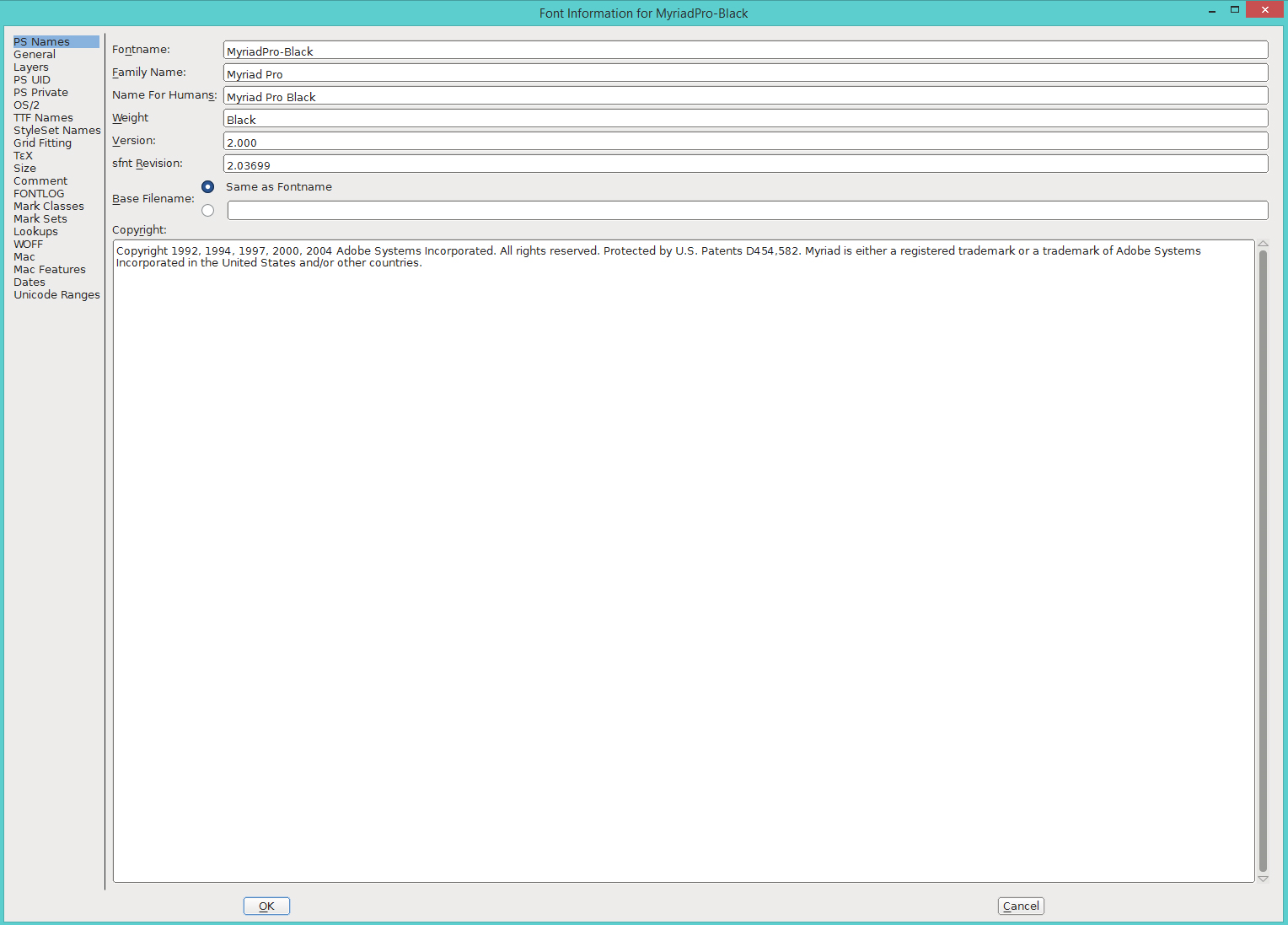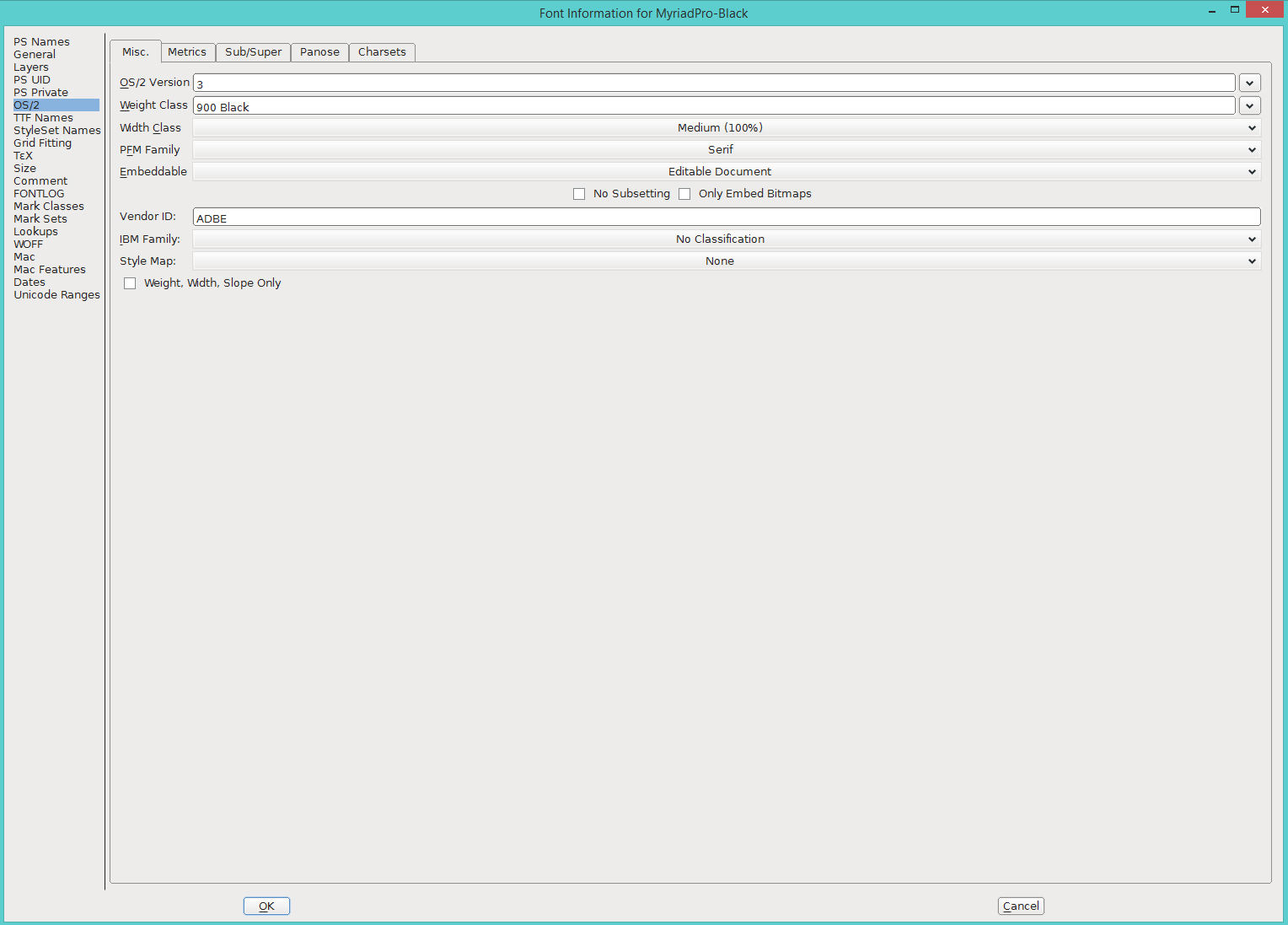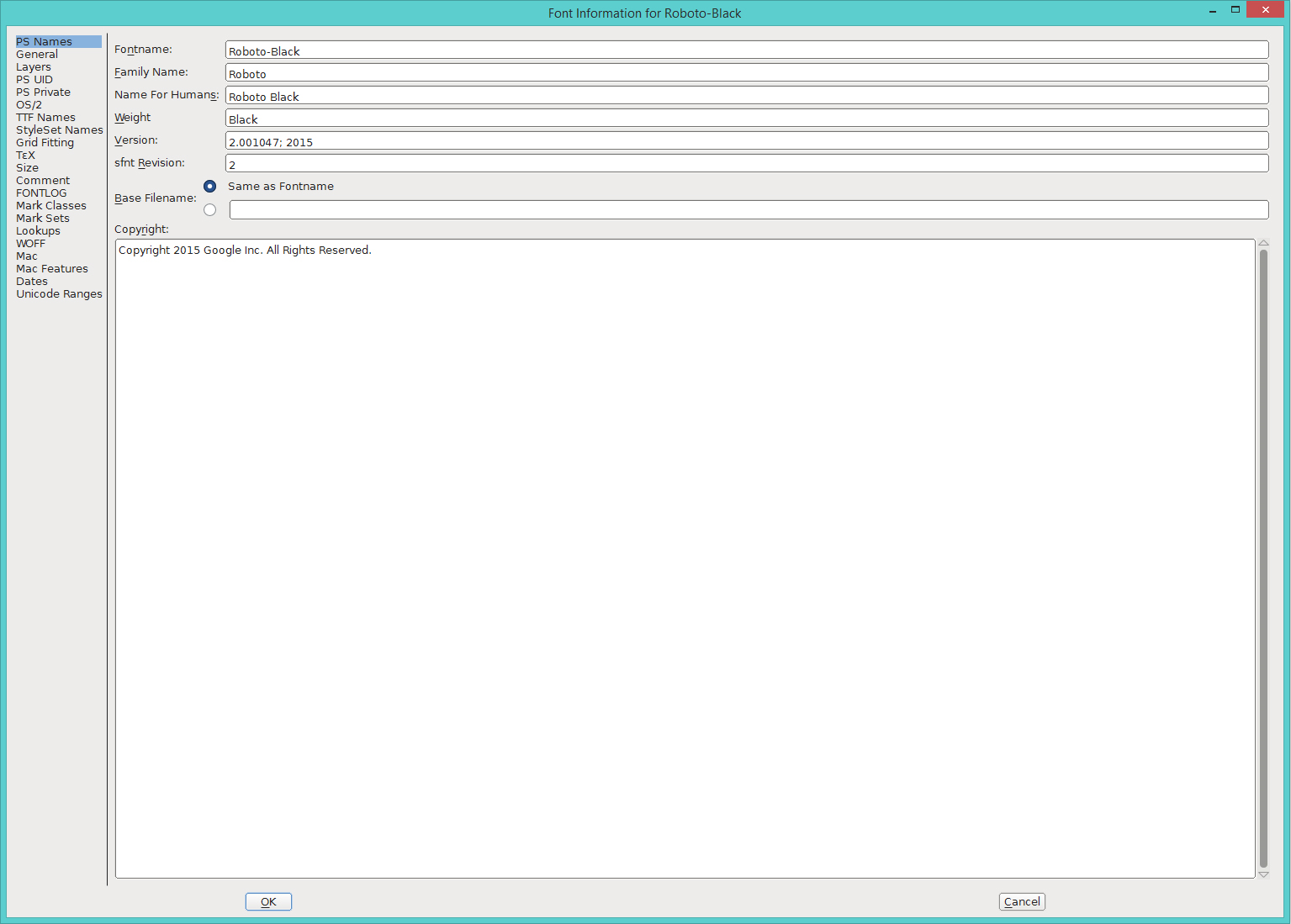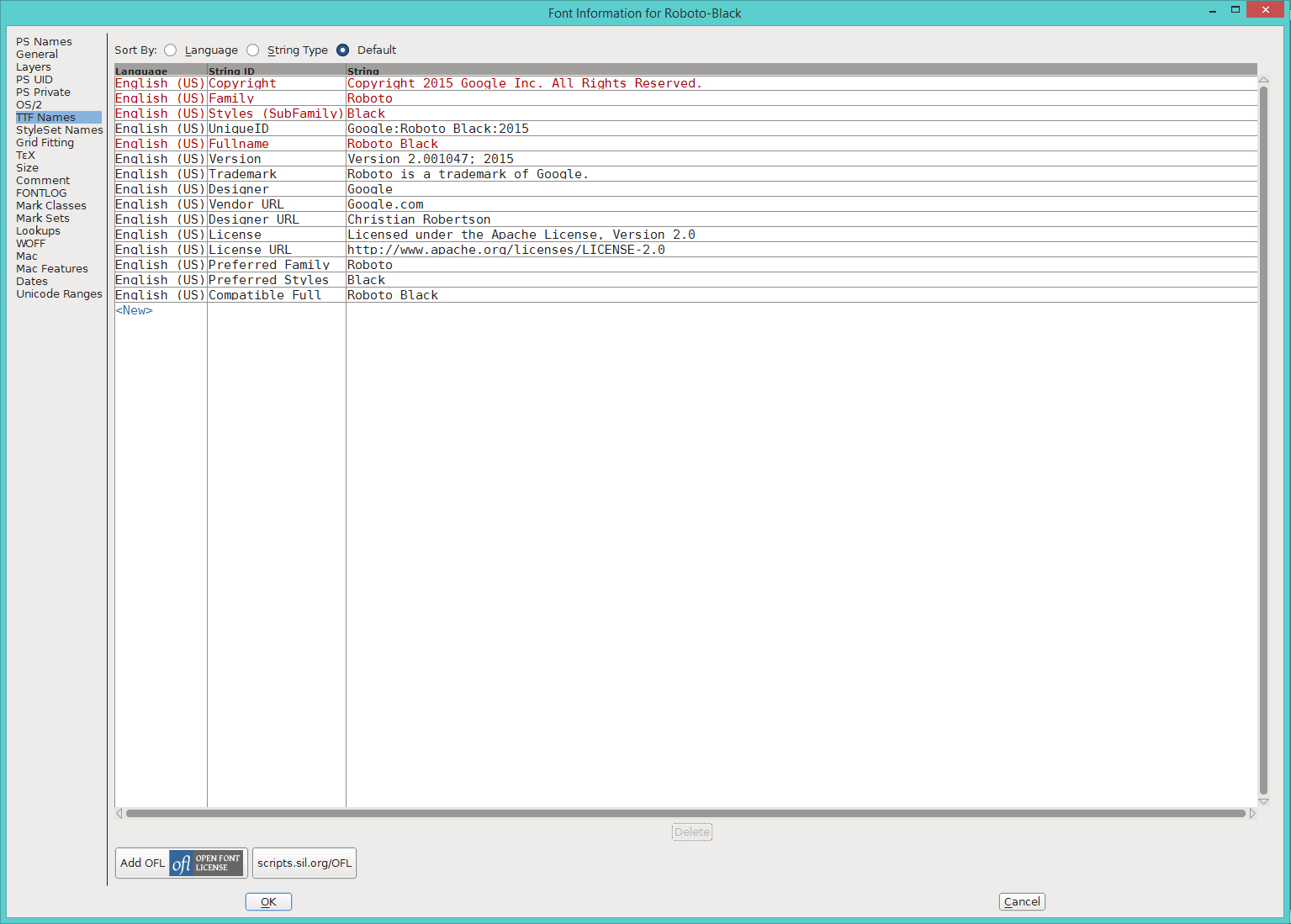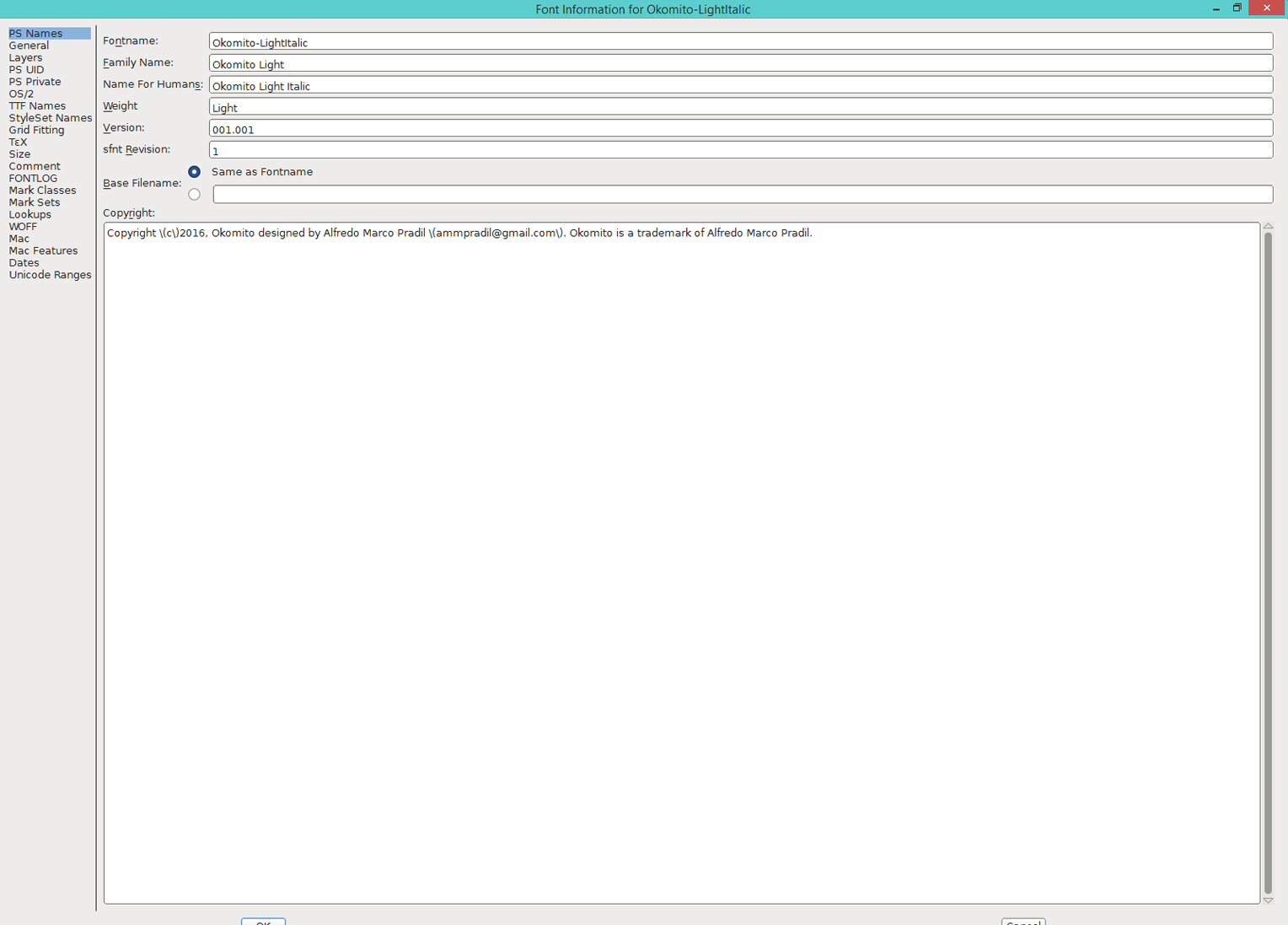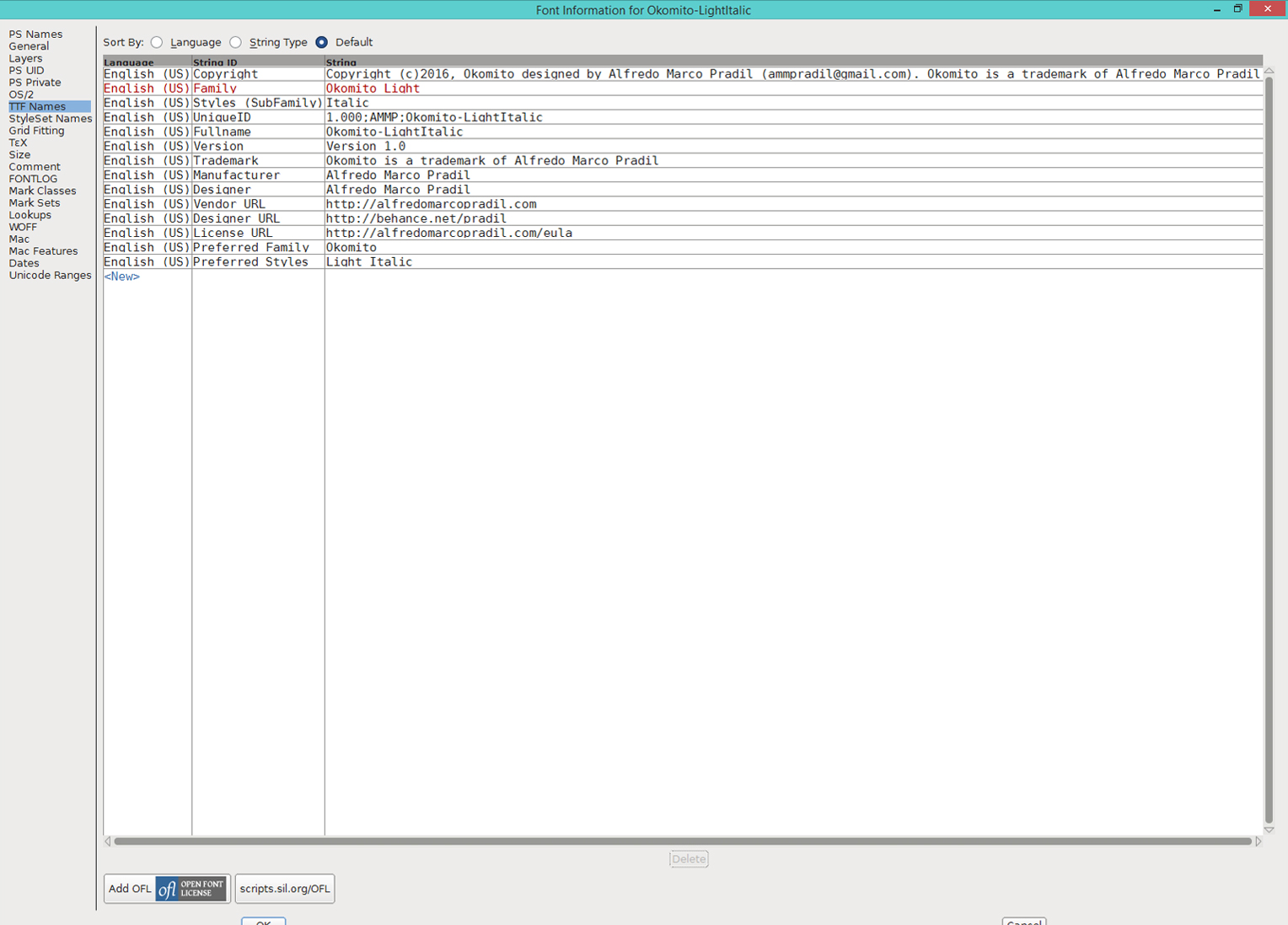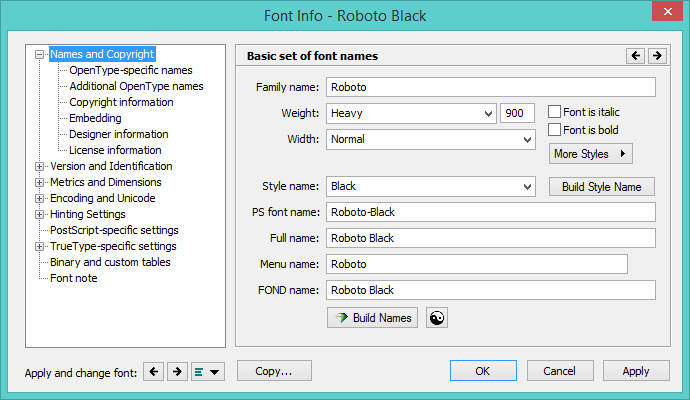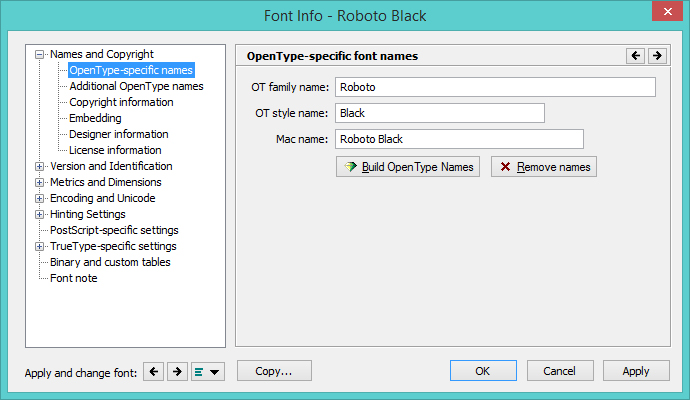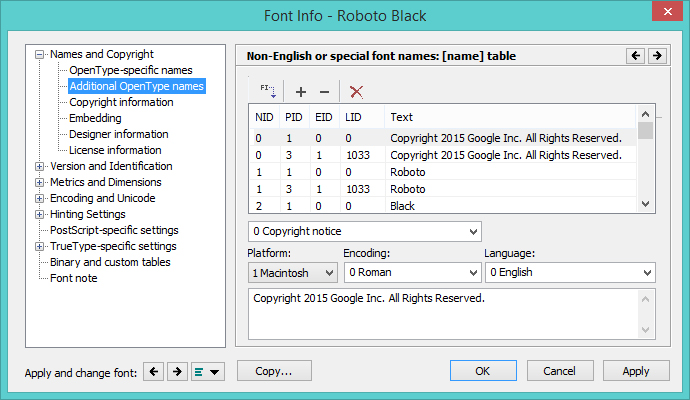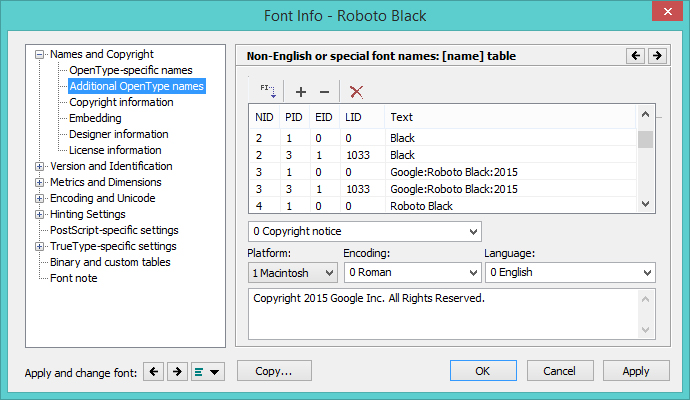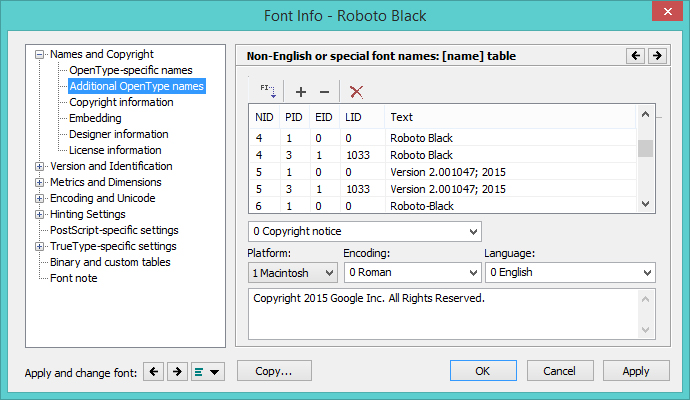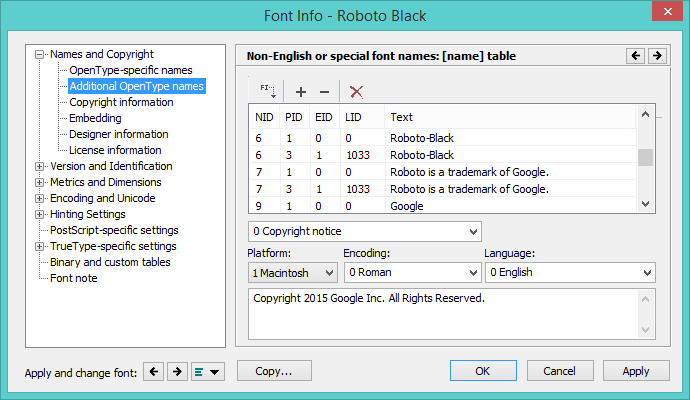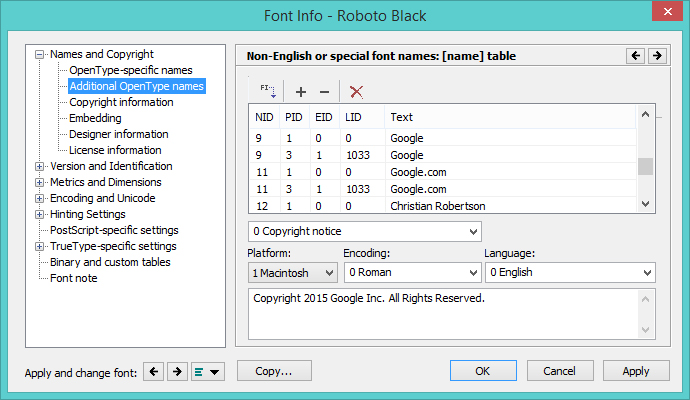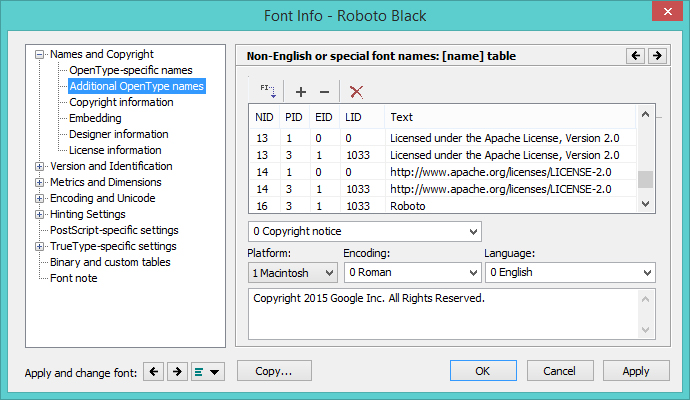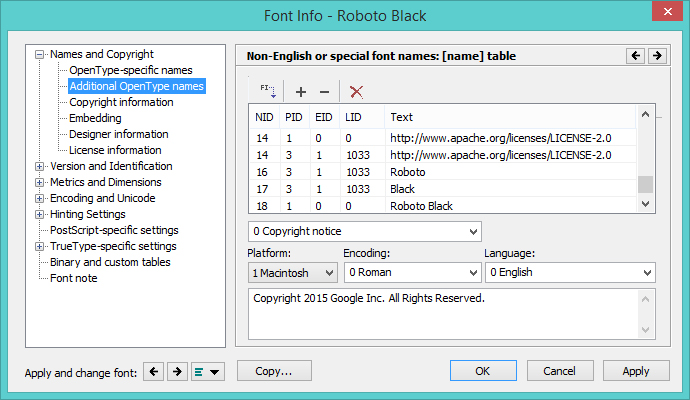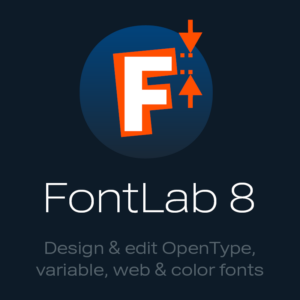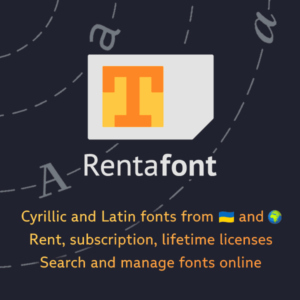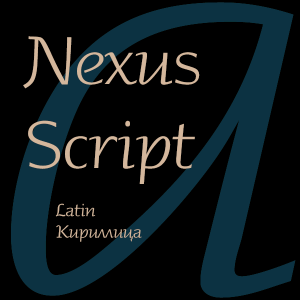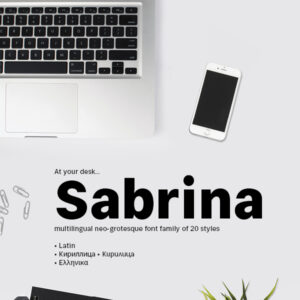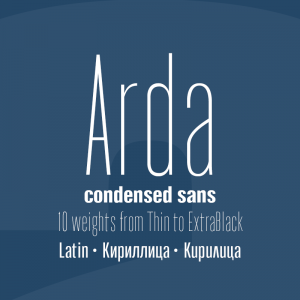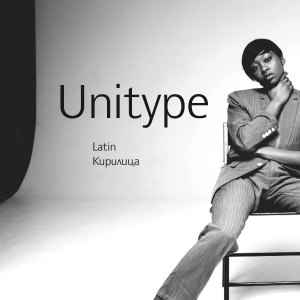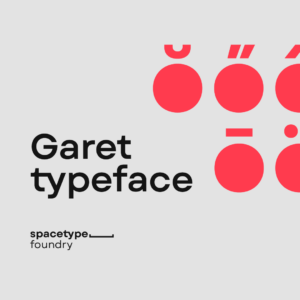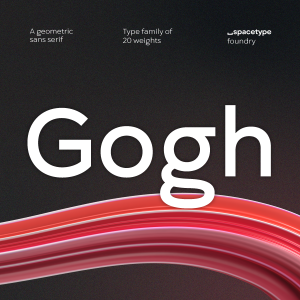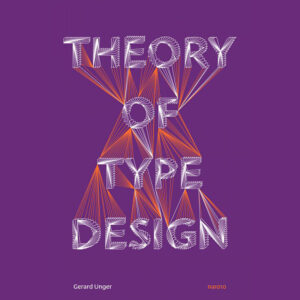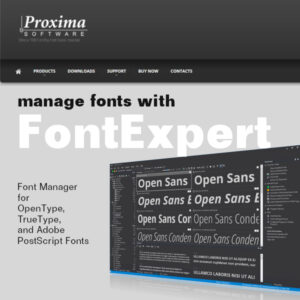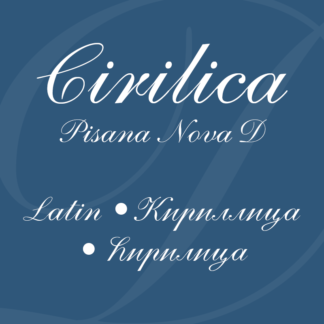| ShortName | Parameter Name | FontLab Studio / Font Info / Names and Copyright | OpenType format fields | Limitations |
| FFN | Full Font Name | Full Name | name.4.1.0.0, name.4.3.1.1033, CFF.FullName | length < 64 chars |
| PSN | PostScript Name | PS Font Name | name.6.1.0.0, name.6.3.1.1033, CFF.FontName | length < 30 chars, no spaces, only A-Za-z0-9 and one hyphen |
| TFN | Typographic Family Name | OpenType-specific names / OT Family Name | name.16.3.1.1033, CFF.FamilyName | length < 32 chars |
| TSN | Typographic Style Name | OpenType-specific names / OT Style Name | name.17.3.1.1033 | length < 32 chars |
| SGN | Styling Group Name | Family Name | name.1.1.0.0, name.1.3.1.1033 | length < 32 chars |
| SLN | Styling Link Name | Style Name | name.2.1.0.0, name.2.3.1.1033 | length < 32 chars |
| Is Bold | Styling Link “is bold” | Font is bold | head.macStyle.bit0, OS/2.fsSelection.bit5 | |
| Is Italic | Styling Link “is italic” | Font is italic | head.macStyle.bit1, OS/2.fsSelection.bit0 | |
| Weight | Weight | Weight (numeric) | CFF.Weight (OS/2.usWeightClass) | value >= 250 and <= 900 in steps of 50, regular must be 400, bold must be 700 |
An example naming scheme for the typographic family called “Demo”:
| PSN | TFN | TSN | SGN | SLN | Is Bold | Is Italic | Weight |
| Demo-UltLig | Demo | Ultra Light | Demo UltLig | Regular | UltraLight (250) | ||
| Demo-UltLigIta | Demo | Ultra Light Italic | Demo UltLig | Italic | X | UltraLight (250) | |
| Demo-Lig | Demo | Light | Demo Lig | Regular | Light (300) | ||
| Demo-LigIta | Demo | Light Italic | Demo Lig | Italic | X | Light (300) | |
| Demo-Reg | Demo | Regular | Demo | Regular | Regular (400) | ||
| Demo-Ita | Demo | Italic | Demo | Italic | X | Regular (400) | |
| Demo-SemBol | Demo | Semibold | Demo SemBol | Regular | Semibold (600) | ||
| Demo-SemBolIta | Demo | Semibold Italic | Demo SemBol | Italic | X | Semibold (600) | |
| Demo-Bol | Demo | Bold | Demo | Bold | X | Bold (700) | |
| Demo-BolIta | Demo | Bold Italic | Demo | Bold Italic | X | X | Bold (700) |
| Demo-Bla | Demo | Black | Demo Bla | Regular | Black (900) | ||
| Demo-BlaIta | Demo | Black Italic | Demo Bla | Italic | X | Black (900) | |
| Demo-Cond | Demo | Condensed | Demo Cond | Regular | Regular (400) | ||
| Demo-CondIta | Demo | Condensed Italic | Demo Cond | Italic | X | Regular (400) |
The following name IDs are pre-defined, and they apply to all platforms unless indicated otherwise. Name IDs 26 to 255, inclusive, are reserved for future standard names. Name IDs 256 to 32767, inclusive, are reserved for font-specific names such as those referenced by a font’s layout features.
| Code | Meaning |
|---|---|
| 0 | Copyright notice. |
| 1 | Font Family name. This family name is assumed to be shared among fonts that differ only in weight or style (italic, oblique).
Font Family name is used in combination with Font Subfamily name (name ID 2). Some applications that use this pair of names assume that a Font Family name is shared by at most four fonts that form a font style-linking group: regular, italic, bold, and bold italic. To be compatible with the broadest range of platforms and applications, fonts should limit use of any given Font Family name in this manner. (This four-way distinction should also be reflected in OS/2.fsSelection bit settings.) For fonts within an extended typographic family that fall outside this four-way distinction, the distinguishing attributes should be reflected in the Font Family name so that those fonts appear as a separate font family. For example, the Font Family name for the Arial Narrow font is “Arial Narrow”; the Font Family name for the Arial Black font is “Arial Black”. (Note that, in such cases, name ID 16 should also be included with a shared name that reflects the full, typographic family.) |
| 2 | Font Subfamily name. The Font Subfamily name distinguishes the fonts in a group with the same Font Family name (name ID 1). This is assumed to address style (italic, oblique) and weight variants only. A font with no distinctive weight or style (e.g. medium weight, not italic, and OS/2.fsSelection bit 6 set) should use the string “Regular” as the Font Subfamily name (for English language).
Font Subfamily name is used in combination with Font Family name (name ID 1). Some applications that use this pair of names assume that a Font Family name is shared by at most four fonts that form a font style-linking group. These four fonts may have Subfamily name values that reflect various weights or styles, with four-way “Bold” and “Italic” style-linking relationships indicated using OS/2.fsSelection bits 0, 5 and 6. Within an extended typographic family that includes fonts beyond regular, bold, italic, or bold italic, distinctions are made in the Font Family name, so that fonts appear to be in separate families. In some cases, this may lead to specifying a Subfamily name of “Regular” for a font that might not otherwise be considered a regular font. For example, the Arial Black font has a Font Family name of “Arial Black” and a Subfamily name of “Regular”. (Note that, in such cases, name IDs 16 and 17 should also be included, using a shared value for name ID 16 that reflects the full typographic family, and values for name ID 17 that appropriately reflect the actual design variant of each font.) |
| 3 | Unique font identifier |
| 4 | Full font name that reflects all family and relevant subfamily descriptors. The full font name is generally a combination of name IDs 1 and 2, or of name IDs 16 and 17, or a similar human-readable variant.
For fonts in extended typographic families (that is, families that include more than regular, italic, bold, and bold italic variants), values for name IDs 1 and 2 are normally chosen to provide compatibility with certain applications that assume a family has at most four style-linked fonts. In that case, some fonts may end up with a Subfamily name (name ID 2) of “Regular” even though the font would not be considered, typographically, a regular font. For such non-regular fonts in which name ID 2 is specified as “Regular”, the “Regular” descriptor would generally be omitted from name ID 4. For example, the Arial Black font has a Font Family name (name ID 1) of “Arial Black” and a Subfamily name (name ID 2) of “Regular”, but has a full font name (name ID 4) of “Arial Black”. Note that name IDs 16 and 17 should also be included in these fonts, and that name ID 4 would typically be a combination of name IDs 16 and 17, without needing any additional qualifications regarding “Regular”. |
| 5 | Version string. Should begin with the syntax ‘Version <number>.<number>’ (upper case, lower case, or mixed, with a space between “Version” and the number).
The string must contain a version number of the following form: one or more digits (0-9) of value less than 65,535, followed by a period, followed by one or more digits of value less than 65,535. Any character other than a digit will terminate the minor number. A character such as “;” is helpful to separate different pieces of version information. The first such match in the string can be used by installation software to compare font versions. Note that some installers may require the string to start with “Version ”, followed by a version number as above. |
| 6 | PostScript name for the font; Name ID 6 specifies a string which is used to invoke a PostScript language font that corresponds to this OpenType font. When translated to ASCII, the name string must be no longer than 63 characters and restricted to the printable ASCII subset, codes 33 to 126, except for the 10 characters ‘[‘, ‘]’, ‘(‘, ‘)’, ‘{‘, ‘}’, ‘<‘, ‘>’, ‘/’, ‘%’.In a CFF OpenType font, there is no requirement that this name be the same as the font name in the CFF’s Name INDEX. Thus, the same CFF may be shared among multiple font components in a Font Collection. See the ‘name’ table section of “Recommendations for OpenType fonts” for additional information. |
| 7 | Trademark; this is used to save any trademark notice/information for this font. Such information should be based on legal advice. This is distinctly separate from the copyright. |
| 8 | Manufacturer Name. |
| 9 | Designer; name of the designer of the typeface. |
| 10 | Description; description of the typeface. Can contain revision information, usage recommendations, history, features, etc. |
| 11 | URL Vendor; URL of font vendor (with protocol, e.g., http://, ftp://). If a unique serial number is embedded in the URL, it can be used to register the font. |
| 12 | URL Designer; URL of typeface designer (with protocol, e.g., http://, ftp://). |
| 13 | License Description; description of how the font may be legally used, or different example scenarios for licensed use. This field should be written in plain language, not legalese. |
| 14 | License Info URL; URL where additional licensing information can be found. |
| 15 | Reserved. |
| 16 | Typographic Family name: The typographic family grouping doesn’t impose any constraints on the number of faces within it, in contrast with the 4-style family grouping (ID 1), which is present both for historical reasons and to express style linking groups. If name ID 16 is absent, then name ID 1 is considered to be the typographic family name. (In earlier versions of the specification, name ID 16 was known as “Preferred Family”.)</> |
| 17 | Typographic Subfamily name: This allows font designers to specify a subfamily name within the typographic family grouping. This string must be unique within a particular typographic family. If it is absent, then name ID 2 is considered to be the typographic subfamily name. (In earlier versions of the specification, name ID 17 was known as “Preferred Subfamily”.) |
| 18 | Compatible Full (Macintosh only); On the Macintosh, the menu name is constructed using the FOND resource. This usually matches the Full Name. If you want the name of the font to appear differently than the Full Name, you can insert the Compatible Full Name in ID 18. |
| 19 | Sample text; This can be the font name, or any other text that the designer thinks is the best sample to display the font in. |
| 20 | PostScript CID findfont name; Its presence in a font means that the nameID 6 holds a PostScript font name that is meant to be used with the “composefont” invocation in order to invoke the font in a PostScript interpreter. See the definition of name ID 6.
The value held in the name ID 20 string is interpreted as a PostScript font name that is meant to be used with the “findfont” invocation, in order to invoke the font in a PostScript interpreter. See “Recommendations for OTF fonts” for additional information |
| 21 | WWS Family Name. Used to provide a WWS-conformant family name in case the entries for IDs 16 and 17 do not conform to the WWS model. (That is, in case the entry for ID 17 includes qualifiers for some attribute other than weight, width or slope.) If bit 8 of the fsSelection field is set, a WWS Family Name entry should not be needed and should not be included. Conversely, if an entry for this ID is include, bit 8 should not be set. (See OS/2 ‘fsSelection’ field for details.) Examples of name ID 21: “Minion Pro Caption” and “Minion Pro Display”. (Name ID 16 would be “Minion Pro” for these examples.) |
| 22 | WWS Subfamily Name. Used in conjunction with ID 21, this ID provides a WWS-conformant subfamily name (reflecting only weight, width and slope attributes) in case the entries for IDs 16 and 17 do not conform to the WWS model. As in the case of ID 21, use of this ID should correlate inversely with bit 8 of the fsSelection field being set. Examples of name ID 22: “Semibold Italic”, “Bold Condensed”. (Name ID 17 could be “Semibold Italic Caption”, or “Bold Condensed Display”, for example.) |
| 23 | Light Background Palette. This ID, if used in the CPAL table’s Palette Labels Array, specifies that the corresponding color palette in the CPAL table is appropriate to use with the font when displaying it on a light background such as white. Name table strings for this ID specify the user interface strings associated with this palette. |
| 24 | Dark Background Palette. This ID, if used in the CPAL table’s Palette Labels Array, specifies that the corresponding color palette in the CPAL table is appropriate to use with the font when displaying it on a dark background such as black. Name table strings for this ID specify the user interface strings associated with this palette |
| 25 | Variations PostScript Name Prefix. If present in a variable font, it may be used as the family prefix in the PostScript Name Generation for Variation Fonts algorithm. The character set is restricted to ASCII-range uppercase Latin letters, lowercase Latin letters, and digits. All name strings for name ID 25 within a font, when converted to ASCII, must be identical. See Adobe Technical Note #5902: “PostScript Name Generation for Variation Fonts” for reasons to include name ID 25 in a font, and for examples. For general information on OpenType Font Variations, see the chapter, OpenType Font Variations Overview. |
Note that while both Apple and Microsoft support the same set of name strings, the interpretations may be somewhat different. But since name strings are stored by platform, encoding and language (placing separate strings for both Apple and MS platforms), this should not present a problem.
The key information for this table for Microsoft platforms relates to the use of strings 1, 2, 4, 16 and 17. Note that some newer applications will use name IDs 16 and 17, while some legacy applications require name IDs 1 and 2 and also assume certain limitations on these values (see descriptions of name IDs 1 and 2 above). Fonts should include all of these strings for the broadest application compatibility. To better understand how to set values for these name IDs, some examples of name usage, weight class and style flags have been created.
Note that OS/2 and Windows both require that all name strings be defined in Unicode. Thus all ‘name’ table strings for platform ID = 3 (Windows) will require two bytes per character. Macintosh fonts require single byte strings.
Note that, for a typographic family that includes member faces that differ from Regular in relation to attributes other than weight, width or slope, there may also be some member faces that differ only in relation to these three attributes. IDs 21 and 22 should be used only in those fonts that differ from the Regular face in terms of an attribute other than weight, width or slope.
Examples
The following are examples of how these strings might be defined, based on Times New Roman Bold:
0. The copyright string from the font vendor. © Copyright the Monotype Corporation plc, 1990
1. The name the user sees. Times New Roman
2. The name of the style. Bold
3. A unique identifier that applications can store to identify the font being used. Monotype: Times New Roman Bold:1990
4. The complete, unique, human readable name of the font. This name is used by Windows. Times New Roman Bold
5. Release and version information from the font vendor. Version 1.00 June 1, 1990, initial release
6. The name the font will be known by on a PostScript printer. TimesNewRoman-Bold
7. Trademark string. Times New Roman is a registered trademark of the Monotype Corporation.
8. Manufacturer. Monotype Corporation plc
9. Designer. Stanley Morison
10. Description. Designed in 1932 for the Times of London newspaper. Excellent readability and a narrow overall width, allowing more words per line than most fonts.
11. URL of Vendor. http://www.monotype.com
12. URL of Designer. http://www.monotype.com
13. License Description. This font may be installed on all of your machines and printers, but you may not sell or give these fonts to anyone else.
14. License Info URL. http://www.monotype.com/license/
15. Reserved.
16. Preferred Family. No name string present, since it is the same as name ID 1 (Font Family name).
17. Preferred Subfamily. No name string present, since it is the same as name ID 2 (Font Subfamily name).
18. Compatible Full (Macintosh only). No name string present, since it is the same as name ID 4 (Full name).
19. Sample text. The quick brown fox jumps over the lazy dog.
20. PostScript CID findfont name. No name string present. Thus, the PostScript Name defined by name ID 6 should be used with the “findfont” invocation for locating the font in the context of a PostScript interpreter.
21. WWS family name: Since Times New Roman is a WWS font, this field does not need to be specified. If the font contained styles such as “caption”, “display”, “handwriting”, etc, that would be noted here.
22. WWS subfamily name: Since Times New Roman is a WWS font, this field does not need to be specified.
23. Light background palette name. No name string present, since this is not a color font.
24. Dark background palette name. No name string present, since this is not a color font.
25. Variations PostScript name prefix. No name string present, since this is not a variable font.
The following is an example of only name IDs 6 and 20 in the CFF OpenType Japanese font Kozuka Mincho Std Regular (other name IDs are also present in this font):
6. PostScript name: KozMinStd-Regular. Since a name ID 20 is present in the font (see below), then the PostScript name defined by name ID 6 should be used with the “composefont” invocation for locating the font in the context of a PostScript interpreter.
20. PostScript CID findfont name: KozMinStd-Regular-83pv-RKSJ-H, in a name record of Platform 1 [Macintosh], Platform-specific script 1 [Japanese], Language: 0xFFFF [English]. This name string is a PostScript name that should be used with the “findfont” invocation for locating the font in the context of a PostScript interpreter, and is associated with the encoding specified by the following cmap subtable, which must be present in the font: Platform: 1 [Macintosh]; Platform-specific encoding: 1 [Japanese]; Language: 0 [not language-specific].
The following is an example of family/subfamily naming for an extended, WWS-only family. Consider Adobe Caslon Pro, with six members: upright and italic versions of regular, semibold and bold weights. (Bit 8 of the fsSelection field of the OS/2 table, version 4, should be set for all six fonts, and none should include ‘name’ entries for IDs 21 or 22.)
- Adobe Caslon Pro Regular:
Name ID 1: Adobe Caslon Pro
Name ID 2: Regular - Adobe Caslon Pro Italic:
Name ID 1: Adobe Caslon Pro
Name ID 2: Italic - Adobe Caslon Pro Semibold:
Name ID 1: Adobe Caslon Pro
Name ID 2: Bold
Name ID 16: Adobe Caslon Pro
Name ID 17: Semibold - Adobe Caslon Pro Semibold Italic:
Name ID 1: Adobe Caslon Pro
Name ID 2: Bold Italic
Name ID 16: Adobe Caslon Pro
Name ID 17: Semibold Italic - Adobe Caslon Pro Bold:
Name ID 1: Adobe Caslon Pro Bold
Name ID 2: Regular
Name ID 16: Adobe Caslon Pro
Name ID 17: Bold - Adobe Caslon Pro Bold Italic:
Name ID 1: Adobe Caslon Pro Bold
Name ID 2: Italic
Name ID 16: Adobe Caslon Pro
Name ID 17: Bold Italic
The following is an example of family/subfamily naming for an extended, non-WWS family. Consider Minion Pro Opticals, with 32 member fonts: upright and italic versions of regular, medium, semibold and bold weights in each of four optical sizes: regular, caption, display and subhead. The following show names for a sampling of the fonts in this family. (Bit 8 of the fsSelection field in the OS/2 table, version 4, should be set in those fonts that do not include ‘name’ entries for IDs 21 or 22, and only in those fonts.)
- Minion Pro Regular:
Name ID 1: Minion Pro
Name ID 2: Regular - Minion Pro Italic:
Name ID 1: Minion Pro
Name ID 2: Italic - Minion Pro Semibold:
Name ID 1: Minion Pro SmBd
Name ID 2: Regular
Name ID 16: Minion Pro
Name ID 17: Semibold - Minion Pro Semibold Italic:
Name ID 1: Minion Pro SmBd
Name ID 2: Italic
Name ID 16: Minion Pro
Name ID 17: Semibold Italic - Minion Pro Caption:
Name ID 1: Minion Pro Capt
Name ID 2: Regular
Name ID 16: Minion Pro
Name ID 17: Caption
Name ID 21: Minion Pro Caption
Name ID 22: Regular - Minion Pro Semibold Italic Caption:
Name ID 1: Minion Pro SmBd Capt
Name ID 2: Italic
Name ID 16: Minion Pro
Name ID 17: Semibold Italic Caption
Name ID 21: Minion Pro Caption
Name ID 22: Semibold Italic
Source: Microsoft Typography: Naming Table
Other sources
Microsoft Typography: Naming Table
Apple: The ‘name’ table
Создание имён в больших шрифтовых гарнитурах
Font Naming Issues. Adobe Tehnical Notes 5088
Family Name and Style Name
How to make fonts work like a family?
Designing Type in FontLab VI » Organizing Font Families
Glyphs: Naming
Typeface name check
Karsten Lücke: Font Naming















































































